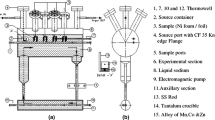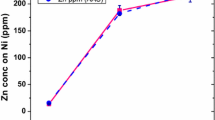Abstract
Primary components of sodium cooled fast reactors get contaminated due to activity transport that occurs from core to out-of-core through coolant which causes activity burden to the personnel during operation and maintenance. To minimize the MAN-REM issues it is necessary to scavenge 54Mn, 60Co and 65Zn which are of major radiological concern from primary sodium using a compact device. Experimental studies were performed at various durations and temperatures with nickel as single trap material to trap the radionuclides simultaneously and its uptake was estimated. Trapping efficiency of porous and non-porous Ni at 773 K was estimated using radiotracer technique.



Similar content being viewed by others
Data availability
The authors do not have the permission to share the data.
References
Mathews CK (1993) Liquid sodium-The heat transport medium in fast reactors. Bull Mater Sci 16:477
Awasthi SP, Borgstedt HU (1983) An assessment of solubility of some transition metals (Fe, Mn and Cr) in liquid sodium. J Nucl Mater 116:103
Polley MV, Skyrme G (1978) An analysis of radioactive corrosion product transfer in sodium loop systems. J Nucl Mater 75:226
Cooper MH, Taylor GR (1975) A transport model for radioactive corrosion product deposition in an LMFBR. Nucl Eng Desig 32:246
Jose MT, Ravi T, Krishnakumar DN, Meenakshisundaram V (2009) Radioactive contamination measurements of the primary sodium pipes in FBTR by gamma spectrometry. Ann Nucl Energy 36:641
McGuire JC, Brehm WF (1980) Radionuclides trap for liquid-metal-cooled reactors. Nuc Tech 48:101
Sivasubramanian K (2005) Comparison of binding energy to the sorption enthalpy of radionuclides with trap materials used in LMFBRs. J Nucl Mater 341:90
McGuire JC (1980) Radionuclide Trap, United States Patent 4088533
Fission and corrosion product behavior in liquid metal fast breeder reactors (LMFBRs), International Atomic Energy Agency, Technical document TECDOC- 687, 1993, pp. 122
Miwa S, Revankar ST (2009) Hydrodynamic characterization of nickel metal foam, Part 1: SINGLE-PHASE permeability. Trans porous Med 80:269
Manivannan A, Rao JSB, Kumar R, Kumar GR, Thangamani M, Sudha R, Umamaheswari R, Muralidaran P, Anthonysamy S (2018) Studies on the up-take behavior of nickel foam for the activated products from liquid sodium using instrumental neutron activation analysis (INAA). J Radio Nucl Chem 317:45
Manivannan A, Sudha R, Maharajan S, Shaji D, Umamaheswari R, Joseph K, Jayaraman V (2021) Studies on the uptake behavior of nickel from flowing sodium for Mn, Co and Zn. J Radio Nucl Chem 329:591
Jana P, Manivannan A, Mahato SK, Sudha R, Muralidaran P, Ganesan V (2014) Nickel foam for trapping manganese and cobalt from liquid sodium. Trans Indian Inst Met 68:169
Stull DR, Prophet H, JANAF (1970) Thermochemical Tables, Second Edition, Nsrds, NBS- 37, USA (1970).
Stanaway WP, and Thompson R, (1980) Proc. Second Int. Conf. on Liquid Metal Technology in Energy Production, Conf-800401-p2, (Richland, Washington), pp 18–54
Awasthi SP, Borgstedt HU (1983) An assessment of solubility of some transition metals (Fe, Ni, Mn and Cr) in liquid sodium. J Nucl Mater 116:103
Acknowledgements
The authors grateful to Shri. Bramhaji Rao for his constant support during calibration of counting system and Mrs. J. Vithya for handling radioactive source. The authors thank Dr.N.Sivaraman,Director, MC&MFCG for constant support and encouragement in this study.
Author information
Authors and Affiliations
Corresponding author
Ethics declarations
Conflict of interest
The authors declare that they have no known competing financial interests or personal relationships that could have appeared to influence the work reported in this paper.
Additional information
Publisher's Note
Springer Nature remains neutral with regard to jurisdictional claims in published maps and institutional affiliations.
Rights and permissions
Springer Nature or its licensor (e.g. a society or other partner) holds exclusive rights to this article under a publishing agreement with the author(s) or other rightsholder(s); author self-archiving of the accepted manuscript version of this article is solely governed by the terms of such publishing agreement and applicable law.
About this article
Cite this article
Manivannan, A., Ravisankar, P., Saravanan, G. et al. Tracer technique to estimate the efficiency of radionuclide trap material in liquid sodium. J Radioanal Nucl Chem 333, 175–178 (2024). https://doi.org/10.1007/s10967-023-09179-7
Received:
Accepted:
Published:
Issue Date:
DOI: https://doi.org/10.1007/s10967-023-09179-7




